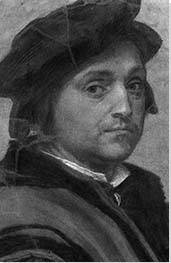Summary of Andrea del Sarto
Del Sarto was the most important Florentine painter of the early 16th century. Associated with religious paintings, and the occasional portrait, his style is revered for the natural poise and grace of his figures and his skill as a colorist. Once the "holy trinity" of Leonardo, Raphael, and Michelangelo had all moved on from Florence (by 1508), del Sarto assumed the mantle of the leading Florentine master (overtaking even Bartolommeo). He modified Leonardo's sfumato technique by introducing a warmer and more vivid range of colours into his palette. Indeed, del Sarto produced a tonal range of color that was unsurpassed and proved a major inspiration on what would soon become known as the Mannerist style.
Accomplishments
- Del Sarto possessed a comprehensive understanding of the great masters of the day. He learned the rules of balance and harmony from Raphael and the delicate skill of chiaroscuro and sfumato from Leonardo. But to this he brought a spontaneity, especially in his earlier works, to religious figures that are not overtly idealized. His figures were posed in a more naturalistic way and this lent his paintings an added emotional, sometimes even playful, dimension.
- Very possibly due to his upbringing as the son of a tailor, del Sarto's skill at rendering the color, texture and fall of clothes and drapery was unmatched by any of his contemporaries. His figures and interiors were infused with an intense range of hues that brought a lively animation to his religious vignettes and tableaus. His willingness to bring this decorative element to his work anticipated the rise of Mannerism.
- Although not a recognized landscapist or portraitist, del Sarto proved highly adept in both mediums. He sometimes set his religious parables against the spectacular backdrop of the Tuscan landscape which he captured to impressive atmospheric effect. In respect of portraiture, meanwhile, he demonstrated his dexterity in this sphere through his rendering of crowd scenes that frequently featured fellow artists (Jacopo Sansovino and musician Francesco de Layolle for instance) and also self-portraits.
- As del Sarto matured as a painter, his work became more restrained and more idealized. This can be directly attributed to the "Roman influence" that saw him absorb some of the humanist precision of Michelangelo and Raphael's skill at infusing his scenes of assembly with dynamism and movement. Yet del Sarto was above mere imitation and his works always managed to retain both their element of intimacy and their allegiance to Florentine civic pride.
The Life of Andrea del Sarto
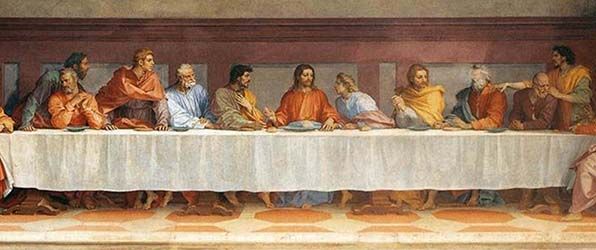
Remarking on del Sarto's "most spectacular masterpiece", The Last Supper, Giorgio Vasari wrote that the artists "gave such infinite grace, grandeur, and majesty to all the figures" that he did not know how to praise it "without saying too little, it being so fine that whoever sees it is stupefied".
Important Art by Andrea del Sarto
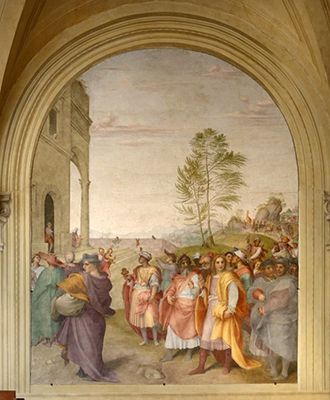
Procession of the Magi / The Journey of the Magi
This fresco depicts the biblical account of the three Magi arriving at King Herod's palace. The lower foreground, and right side of the painting, are dominated by an animated crowd of foreign merchants carrying exotic goods and animals (including a giraffe visible in the right background). On the left, del Sarto has rendered the edge of Herod's palace with careful foreshortening. One of the unusual things about this fresco is the beautiful Tuscan countryside that forms the painting's backdrop.
This crowd of merchants also features portraits of Sarto's contemporaries, demonstrating thus his skill as a portraitist. On the right, one can observe a portrait of the sculptor Jacopo Sansovino (with whom he worked between 1511-17) standing beside the musician Francesco de Layolle. The painting also includes a self-portrait (visible to the left of Sansovino). A prominent rock in the painting's lower foreground bears the artist's signature which is composed of two interlocking "As".
This fresco is located in the Court of the Servi in the pilgrimage church of Santissima Annunziata in Florence, and forms part of Sarto's first important public commission of 1509. Like his other early works, this painting is infused with a palpable energy and dynamism. The figures are not refined, polished, or idealised, as they would become in his later art; their poses are relaxed and appear quite natural. As the son of a Florentine tailor, Sarto also enjoyed rendering the texture and fall of drapery. Indeed, in this painting each figure is adorned in a different coloured garment which brings an added element of animation the scene.
Fresco - Santissima Annunziata, Florence
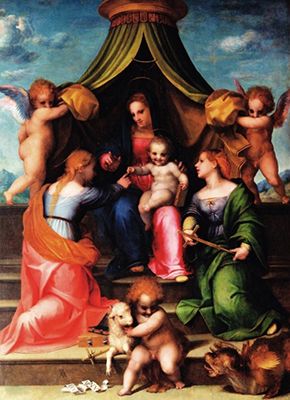
Mystic Marriage of Saint Catherine of Alexandria
This devotional work is in a style known as Sacra Conversazione (Holy Conversation); a genre of painting that was very popular during the Italian Renaissance. The genre typically depicts the Virgin Mary and the Christ child who is here flanked by two saints, Saint Catherine of Alexandria and Saint Margaret of Antioch (together with her attribute, the sinister dragon she is known for conquering), and the figure of St. John the Baptist as a child in the middle-near foreground (with his attribute of a lamb). The conversion ceremony is being overseen by the Virgin Mary, who enacts a blessing with her right hand, and by Saint Margaret, who watches attentively.
This painting is an early work that displays a number of painterly influences borrowed from del Sarto's contemporaries. To begin with, this panel painting reveals del Sarto's thorough understanding of Leonardo da Vinci's use of chiaroscuro and sfumato while the balance, symmetry, and harmony of the composition carries echoes of Raphael. At the same time, the work exhibits the artist's personal style that was uniquely animated in his early years. The figures are beautiful but not overtly idealized; they exhibit, rather, naturalistic poses that bring an added emotional element to the scene. There is also a sense of playfulness that disrupts the composition's sense of order, and suggests a refreshing degree of confidence in the young artist. Furthermore, the painting is composed of vivid colours; del Sarto's expressive use of intense, saturated hues were unsurpassed in Florentine painting.
Oil on panel - Gemäldegalerie in Dresden
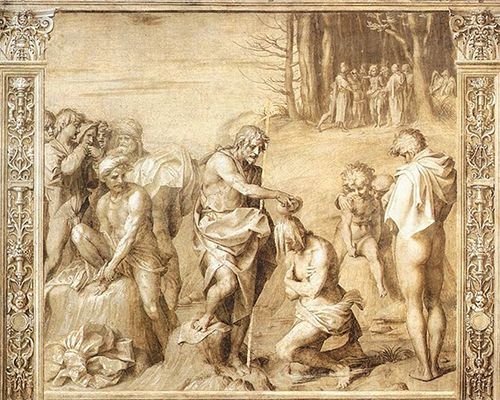
Baptism of the People
This grisaille (grey monochrome) fresco depicts St. John the Baptist in the act of baptising a crowd. It is one of a series of frescoes depicting the life and times of St. John the Baptist in the Chiostro dello Scalzo cloister. Begun around 1511, the work was not completed until 1526, and almost all of the work was completed in del Sarto's own hand. The cycle is considered a masterpiece of Renaissance Art, while K. G. Shearman, Professor of Fine Arts at Harvard University, argued that the frescos read "like an artistic autobiography covering the greater part of his career". Del Sarto's crisp expression of the narrative, his delicate rendering of water and fabrics, as well as his sculptural rendering of the figures, pushed the conventions of monumental fresco painting, and played an important role in the development of Mannerism. The refined forms of the figures also reflect del Sarto's interest in woodcuts by Northern artists such as Martin Schongauer, Albrecht Dürer, and Lucas van Leyden.
Positioned at the very centre of the composition, John the Baptist's right foot is perched on a rock as he pours water from a simple terracotta bowl onto the head of a kneeling figure. He cradles a cane crucifix to the left side of his body. The kneeling figure hugs his own torso as he undergoes his baptism; his feet and right knee are submerged in the river. On either side, figures observe the scene as they wait their turn to be baptised. Some of the figures perch on rocks that sit in the river. In the right background of the fresco, there is another crowd of onlookers standing on a low hill.
Del Sarto has approached this subject matter as a chance to render the human body in different poses and with varying degrees of clothing. For example, there is a figure on the far right wearing a fabric that only covers his upper body; his rear is visible to the viewer. Moreover, on the left, there is a figure that perches elegantly on a rock; the muscles in his legs, arms, and chest are very prominent. The range of different postures reveals the artist's masterful command of the human body and his ability to render its lines and shapes from all angles. Additionally, the scene is framed by an elaborately painted architectural setting which further confirms del Sarto's technical range.
Fresco - Chiostro dello Scalzo
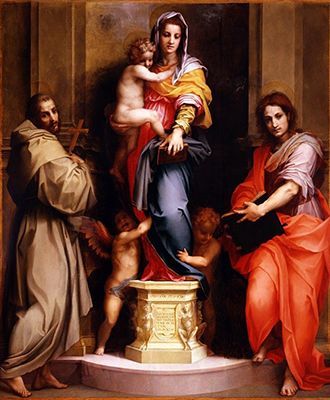
Madonna of the Harpies
The Madonna of the Harpies is a densely symbolic altarpiece. The Virgin Mary stands in the center of the composition, cradling the Christ child with her right hand, and holding a book (symbolizing her wisdom) in her left. She is flanked by two saints while two agitated putti clutch at her calves. The outward gaze of St John the Evangelist and St Francis command the devotional attention of the viewer, while the painting, which carries a rich and expressive use of color, also displays del Sarto's command of fabrics and his ability to represent them as they envelop the forms and contours of the human figure. The title of the painting is based on Vasari's identification of the creatures depicted on the pedestal as harpies. However, a more recent iconographic interpretation, which considers the painting in light of eschatological symbolism (a branch of theology dealing specifically with the idea of judgment and punishment) has led art historians and scholars to view the creatures as the locusts described in St John the Evangelist's Apocalypse. Indeed, on the right of the painting we see the figure of St John himself, balancing an open book on his bent right leg, and likely in the act of writing his prophecies.
In the ninth chapter of his prophecies, St John the Evangelist describes the monstrous beings rising from the well of the abyss in a haze of smoke (seen here rising behind the Virgin). The Harpies possess women's heads and bellies resembling iron breastplates. They are responsible for bringing torment to all who did not bear God's seal - the tau - on their foreheads. This interpretation also accounts for the figure of St Francis in the place of San Bonaventura who was included in the original commissioning contract for the work. In his Legenda Maior (1263), the influential philosopher and theologian, Bonaventura, identifies St Francis as possessing the angel of the sixth seal prophesied by St John the Evangelist. In light of this interpretation, the pedestal the Virgin Mary stands on is read as the well of Hell that she is keeping closed. The complex symbolism of this painting is believed to have been suggested by Antonio di Ludovico Sassolini, the Minister of the Conventual Franciscans of Tuscany at the time.
The central Madonna figure was modelled on Andrea's wife, Lucrezia del Fede of Recanati. Del Sarto regularly used her as a model for his paintings; indeed, she appears in many of his art works and often as a Madonna. His habit of posing his wife explains why his religious figures often possess the immediacy of portraits. Like all of his paintings, however, the work is also an exquisitely-balanced composition. His style here carries the influence of Michelangelo, Raphael, and Leonardo, whose works del Sarto studied meticulously. The elegant compositional structure carries echoes of Raphael (and in particular the pyramidal arrangement of the Virgin Mary); the monumental and statuesque bodies of the figures associated with Michelangelo; and the delicate shading of color and shadow that were trademarks of Leonardo.
Altarpiece in oils - Galleria degli Uffizi
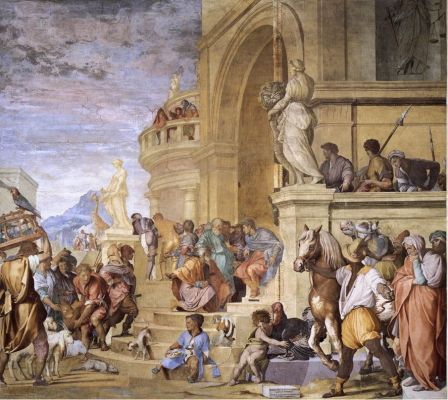
Triumph of Caesar
This fresco depicts Julius Caesar adorned with a laurel-wreath and dressed in a red toga and a blue cloak. He sits (in a somewhat animated pose) on a marble throne under a classical arch and is receiving ambassadors. Caesar is surrounded by standing and kneeling elderly men who are gesturing towards the men bearing vases and exotic animals on the left of the painting. The ambassadors have brought animals with them that include the famous Medici giraffes (in the left background) that were presented to the family in 1487 by a Sultan of Egypt. The painting thus presents the viewer with a captivating mix of ancient Roman history and current affairs by glorifing the Medici family and their triumphant return to Florence and by associating the figure of Caesar with Lorenzo de' Medici himself.
The fresco is located in a trompe-l'oeil loggia framed by columns on one of the long walls of the central hall of the Villa Medicea di Poggio a Caiano. Del Sarto expertly adapted the fresco to suit its modern setting and surrounding, accounting for its angle, its viewing height and the abundance of natural light. The work is an historical allegory that espouses Florentine civic pride. The statues are allegories of Abundance and Justice, and Judith with the (severed) Head of Holofernes (near right) as a symbol of Florentine power. The painted decorations of the villa, meanwhile, were intended to celebrate the pope's father Lorenzo the Magnificent, as well as other family members living there. The iconographical programme was designed by the historian Poalo Giovio and its aim was to celebrate and promote the Medici family through a variety of scenes from Roman history.
In December of 1521, Pope Leo X died, and thus all decorative work in the Salone was immediately halted, leaving del Sarto's fresco incomplete. It was finished and extended between 1578-82 by Alessandro Allori who was commissioned by the Grand Duke Francesco de' Medici. Del Sarto's fresco is a fragment of the original commission that is now incorporated into a much later decorative scheme. Del Sarto's style within the finished fresco is noticeably more polished and ideal than in his earlier paintings, likely due to the influence of Michelangelo. Moreover, this work shows the influence of Raphael, which supports the belief that the artist visited Rome around 1519-20 and studied Raphael's work in detail. Indeed, like Raphael, this painting exhibits an organised composition that is simultaneously crowded with figures in movement and in action.
Fresco - Villa di Poggio a Caiano
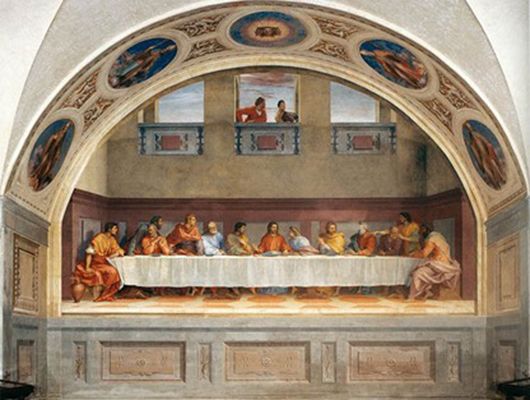
The Last Supper
The San Salvi monastery was founded in 1048 by Saint Giangualberto in dedication to Saint Michael. In the subsequent centuries it was enlarged and decorated with important commissions including the famous Baptism of Christ (1475) by Verrocchio and his pupil at the time, Leonardo da Vinci. At the beginning of the sixteenth century, the building received a large donation from the Abbot Ilario Panichi and the Great Refectory, which would adjoin the bathrooms and kitchen, was added. Abbot Panichi commissioned the young del Sarto to decorate the Cenacolo (upper room) of the refectory. With the assistance of the student portraitist Franciabigio, del Sarto painted the under-arch which features grotesque (grotto style) decorations and five medallions representing the patron saints of the Vallombrosani monks: Saint Giovanni Gualberto, Saint Salvi, Saint Bernard Uberti and Saint Benedict, with the fifth, center, medallion, represented the Triffons, a controversial spiritual symbol reintroduced by the Italian Dominical Friar and preacher, Girolamo Savonarola, where three faces (two in profile, share four eyes) symbolize the Trinity. It would be another fifteen years before del Sarto was recalled to work on the wall painting for The Last Supper which, it is rumoured, took him just 64 days to complete.
According to the building's (now a museum) website, del Sarto "expressed here his artistic maturity, deep devotional intensity and important search on changing color effects throughout the wall". It describes how "all the Apostles are depicted around Jesus, on the same side", while Judah is represented (as he is in the Leonardo masterpiece) "sitting on the right of Jesus [as] he receives from Jesus a piece of bread". The website adds that the "colors are always vivid and bright with unusual iridescent effects reminding [us] of shantung silk: purple, orange, turquoise and green such as for Judah's soft drapery. The skilful use of light and shade gives the fabrics the idea of movement and adds plasticity to each figure". One's eye cannot help but be drawn to the playful upper part of the fresco which features a foreshadowed balcony on which stand two "spying" servants (one holding a serving tray), set against a sunset.
Contradicting his otherwise tempered assessment of del Sarto's talents, Giorgio Vasari wrote in 1568 that this painting was del Sarto's "most spectacular masterpiece and one of the most beautiful paintings in the world [...] it certainly is, the most smooth, the most vivacious in colouring and drawing that he ever did, or rather that anyone could do. For apart from all the rest, he gave such infinite grace, grandeur, and majesty to all the figures that I do not know how to praise his Last Supper without saying too little, it being so fine that whoever sees it is stupefied". Indeed, the fresco was so sublime it survived the 1529-30 siege of Florence when the invading army of Charles V was so spellbound by its modernity and beauty that the convent was spared from destruction. In 1534 the convent was turned into a nunnery and its strict system of enclosure meant that fresco remained hidden from public eyes until the nineteenth century.
Fresco - Convent of San Salvi, Florence
Biography of Andrea del Sarto
Childhood
Although some sources suggest his family name was Lanfranchi, Andrea d'Agnolo di Francesco di Luca was the son of a Florentine tailor (sarto in Italian), hence Andrea del Sarto, "the tailor's son". Little else is known about del Sarto's early childhood except for the fact that he was (and remained) short in stature and his friends called him Andreino.
Early Training and Work
In 1494, aged just eight, del Sarto was apprenticed to a Florentine goldsmith. The experience helped foster his love for drawing and draftsmanship. Soon thereafter he was taken on by the little-known painter and woodcarver Andrea di Salvi Barile, under whom he studied until he reached the age of twelve. According to Giorgio Vasari's Lives of the Most Excellent Painters, Sculptors, and Architects, de Sarto then became the apprentice, first of the painter Piero di Cosimo, and subsequently Raffaellino del Garbo (Carli), a highly accomplished late 15th-century painter.
It was however under the tutelage of di Cosimo, who commented favourably on his student's aptitude for color and his studious mentality, that del Sarto truly came into his own. Like other Florentine artists of the time, di Cosimo was also a metal point draftsman, and he likely taught del Sarto to draw using this method. However, there are no known del Sarto drawings in this medium. He preferred to use red and black chalk for his preliminary drawings given that it allowed for greater tonal variation than the more precise lines of metal point.
The art historian Nigel Ip (himself drawing on an essay by Marzia Faietti) describes how del Sarto's red-chalk drawings were unique "as examples of a synthesis between two opposing theoretical approaches to art-making: Florentine disegno (meaning both design and drawing) and Venetian colore (colour)". He notes that this was "a common debate in the sixteenth century among intellectuals" with many, including Vasari, siding with the view that "the linear precision of disegno was more important than the rendering of insubstantial planes of colore [and] would go on to have a deeper association with divine creation" (as expounded by Vasari in his praise for masters such as Michelangelo).
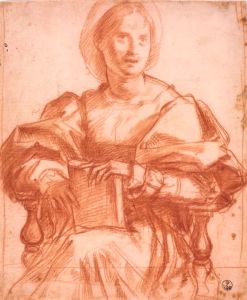
Despite its capacity to render tones in life studies, red chalk drawing came at the expense of fine picture detail. But the art critic Linda Wolk-Simon argues that del Sarto "fully exploited its possibilities". She adds that the "naturalism that is a hallmark of his style must underlie the privileging of red chalk, a medium ideally suited to describing warm, breathing flesh [and that with] their astonishing tonal and colouristic range, his red chalk drawings also hint at the sublime and subtle gifts as a colourist that dazzle in his paintings".
Del Sarto began producing independent work around 1506 and this phase was marked by the artist's youthful spontaneity that gave rise to a naturalistic treatment of his figures. Still aged just 20, he and his friend, Franciabigio (Francesco di Cristofano), opened a studio and shop at a lodging in Piazza del Grano. Two years later, on December 11, 1508, del Sarto matriculated into the painters' guild of Florence. In 1509, he began his long collaboration with the church and convent of Santissima Annunziata (also in Florence). The Servite Order employed him, together with Franciabigio and Andrea Feltrini, to execute a set of five frescoes for the entrance to the cloister. These scenes, depicting the life of St. Filippo Benizzi, would be his first important public commission and confirmed del Sarto as a young painter to be reckoned with.
Mature Period
In 1511, del Sarto moved to a workshop near the church of Santissima Annunziata. He remained there for about six or seven years during which time he apprenticed Rosso Fiorentino and Jacopo Pontormo. He also worked with the sculptor Jacopo Sansovino who is cited as the key influence on del Sarto's maturing, more muscular and sculptural, painting style. Ip writes "The diversity of styles produced by each of these individuals leads one to suggest that [del Sarto's] workshop did not operate in the same manner as other workshops, where pupils were taught to paint under a single style dictated by the master". He adds (through Julian Brooks) that, "there is little to no detailed evidence regarding the structure of [his] workshop nor any insight into its delegation of labour" but that a total of some 180 studio drawings by del Sarto offer "a glimpse of his creative vision, command of draughtsmanship, and interest in sculpture". Del Sarto's workshop became famous to the point that it usurped Fra' Bartolommeo's studio as the leading Florentine workshop.
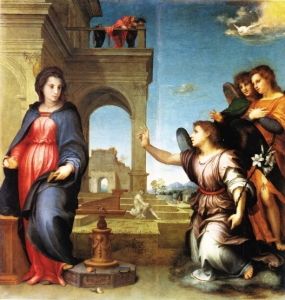
During the period 1511-18 del Sarto executed important frescoes for churches in Florence including the Chiostro dello Scalzo and the monastery of S. Gallo. The Annunciation, for instance, was painted for the convent of San Gallo (and moved before it could be destroyed in the siege of Florence on 1529). According to the "Art in Tuscany" website, the atmosphere of the painting "is charged with ancient references quoted blithely in the theatrical background which forms a setting for the almost unrecognizable biblical story. It is usually interpreted as Susanna and the Elders - a Susanna who resembles a male nude; the Elders, three of them, lightly touched in with a few brushstrokes, are pointing to her up in an airy loggia worthy of Pontormo or Rosso. The two figures of the Madonna and the Angel in the foreground, accompanied by two angels, full of gentle human beauty, are vibrant with poetic intensity". It was this fresco, the website continues, that gave the first indications of del Sarto's "general movement towards a more restrained, sculptural style".
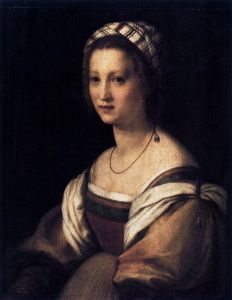
Del Sarto married Lucrezia del Fede of Recanati in 1518. The widow of a hatter named Carlo di Domenico, she brought to the marriage a property and a sizable dowry. According to K. G. Shearman, Professor of Fine Arts at Harvard University, del Sarto "was content to work, when it suited him, for nominal fees, for no remuneration at all, or for only part of a fee offered to him, probably because he was in comfortable circumstances". Most biographical accounts repeat the claim that he would be happy to paint "for a carpenter or a king". Before and following their marriage, del Sarto often used Lucrezia as a model and she appears in many of his paintings, even posing as a Madonna in signature works including The Nativity of the Virgin (1514) and Madonna of the Harpies (1517). Despite doubling as the Madonna, both Vasari, and later, the English playwright and poet Robert Browning (probably drawing on Vasari's earlier accounts), characterised her as an aggressive and jealous woman without religious faith.
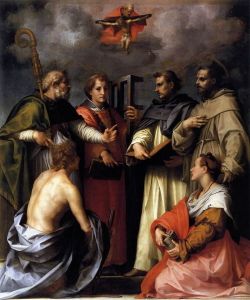
In 1517 del Sarto painted one of his most famous panels for the altar of a chapel in the Augustinian church of San Gallo, Disputation on the Trinity. The altarpiece features St. Augustine, St. Sebastian, St. Lawrence, Peter Martyr, Francis and Mary Magdalen. Del Sarto sets his figures against a somewhat fearsome sky from which emerges the symbol of the Trinity, and which is here being debated by the saints as Magdalene, modelled on Lucrezia (del Sarto's wife), looks on.
In June 1518 del Sarto (who had sent two works to his Court two years earlier) received a personal invitation from the king of France, François I to join his Court. Del Sarto accepted the invitation and left for Fontainebleau with his student Andrea Squarzzella. One can only arrive at the conclusion that del Sarto did not take to life as a court artist given that he stayed less than a year and failed to accept any major commissions. It is thought, however, that two surviving works, The Charity and Portrait of a French Lady, were produced during his short stay in France. According to Vasari's account, Lucrezia, who had remained in Florence, wrote to her husband demanding that he come home. The French King agreed, but on the proviso that del Sarto return to France in the near future.
The rumor spread that François I had supplied del Sarto with funds to purchase artworks to display at his Court. According to Vasari, del Sarto, under the influence of his unscrupulous wife, used the money to purchase a substantial property on Via della Crocetta in Florence and thus destroyed his reputation in the eyes of the French court and any chance of ever being invited back to France. This story, though widespread, is now considered to be fictional (not to mention malicious). However, as Shearman confirms, in 1520 Sarto did begin "to build himself a house in Florence, which was later inhabited and modified by several other painters" adding that it was "a substantial property without being a palace". Following his return from France, del Sarto also received a highly prestigious commission from the Medici family (who had become all powerful since their return to Florence in 1512). He was requested by Pope Leo X to contribute adornments to the salone (lounge area) at the Villa di Poggio a Caiano on the outskirts of Florence, though, in the event, the project was halted following the Pope's death in December 1521.
In 1523, del Sarto accepted an unusual commission from Ottaviano de' Medici. Ottaviano was the owner of Raphael's group portrait featuring Pope Leo X, a masterpiece coveted by Federico II Gonzaga (the Duke of Mantua). Since Ottaviano did not want to lose Raphael's original, he commissioned del Sarto to execute an exact duplicate which he then gave to the Duke in place of the original. Del Sarto's copy was reportedly so exact that it fooled even Giulio Romano, the artist who was responsible for helping render Raphael's original.
In 1524, del Sarto and his family moved briefly to Luco in Mugello to escape an outbreak of the Bubonic Plague in Florence. Later that year del Sarto visited Rome where Michelangelo first introduced him to Vasari. Vasari was impressed enough by del Sarto he became one of his pupils. However, Vasari would later show great ambivalence towards his erstwhile tutor, who, in his view, possessed all the prerequisites of a great artist, but lacked the extra drive and ambition that elevated the works of the "true" Renaissance greats: Michelangelo, Raphael, and Leonardo.
Having said that, Ip records that del Sarto occupied two of the largest entries of Vasari's biography The Lives of the Artists: the first, in 1550, covering 40 pages; the second, in 1568, covering 55 pages. Yet Vasari was critical of del Sarto's "apparent unwillingness to undertake the challenge of assimilating the antique and contemporary works in Rome during his brief stay" (though Ip tells us that Dominique Cordellier's analysis of del Sarto's numerous sheet copies of Michelangelo and Baccio Bandinelli "tells a rather different story"). Vasari did, however, rank del Sarto as amongst the greatest Florentine artists of his era. But while his work possessed "the same naturalistic approach and sense of calm witnessed in the works of previous Florentine artists like Giotto, Masaccio, and Domenico Ghirlandaio", Vasari argued that it was del Sarto's (assumed) lack of "Roman experience" that robbed him of the "'resolute boldness' and abundant invention [of] the bella maniera (beautiful style)".
Troubled by the contradictions in Vasari's account - he described del Sarto's Last Supper (1527) for instance as "one of the most beautiful paintings in the world" - Ip (this time through Wellen) suggests that Vasari's opinion of del Sarto was colored by certain prejudices that fluctuated in his two entries due to the shifting intellectual climates and his distain for the "Florentine communal life".
This criticism surfaces in Vasari's "negative perceptions of members of the compagnie di piacere ["pleasure of his company" club], which included [...] del Sarto and his circle of artist friends. Members of such clubs put on spectacles and lavish dinners, time-wasting activities which Vasari saw as impeding the progression of the arts and the advancement of the artist's social status". But, more pointedly, Vasari's criticism of del Sarto's character was rooted in his pupil, Jacone, who "spoke in slang, visited artists' workshops to criticise their work, and 'always had his mind set more on giving himself a good time and every possible amusement, living in a round of suppers and feasting with his friends'". In Vasari's view, Jacone had "become so lazy and terribly-mannered that his abilities had dropped" and that "such a person would have negatively impacted [del Sarto's] lifestyle and [his own] development as an artist". Ip concludes that Vasari's description of Jacone "echoes qualities associated with [his master, del Sarto] and such a tale comes with a moral to lead a more honourable life in order to gain wealth and fame" (which in Vasari's view was the goal of all great artists).
Contradicting somewhat Vasari's assessment of abilities, in 1926 del Sarto finally completed, after some 15 years in the making, his celebrated monochrome fresco cycle for the cloister at the Scalzo in Florence. Now widely considered one of the defining masterpieces of the High Renaissance, it raised the bar for standards of excellence in monumental fresco painting.
Late Period
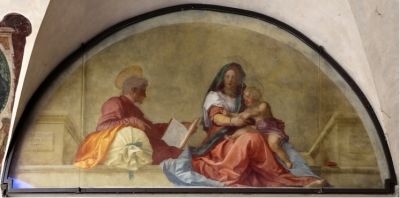
In his late career, del Sarto was content to work for small fees; or for no remuneration at all as was the case with Madonna del Sacco (1525). By this point in his career, del Sarto's style had fully matured and his works exhibit a highly expressive use of colour which was exceptional in Florentine painting. Now revered as one of his most important pieces, Madonna del Sacco was painted for the Basilica della Santissima Annunziata in Florence where the lunette-shaped fresco graces the entrance door of the church's Great Cloister (known as the Chiostro dei morti). Although it exhibits the influence of Michelangelo, and in particular his painted figures in the vault of the Sistine Chapel, the painting is its own celebration of del Sarto's unique style: notably the painting's elegant balance and figures that possess at once an air of grandeur and repose. As the curator of drawings at the J. Paul Getty museum Julian Brooks has stated, del Sarto had with this fresco managed to convey "a wonderful balance of dignity and informality".
The Medici were once more expelled from Florence in 1527 and del Sarto worked for the republican government of Florence. One of his late pieces, Sacrifice of Isaac (one of three versions del Sarto executed), was in fact offered as a political gift to Francis I. The increasing idealization and intense coloring, as in devotional paintings such as the Quattro Santi (1528) and St. Agnes (1528), stand as prime examples of the move away from the High Renaissance style (which was thought to have reached its point excellence and could not be improved upon) towards the more decorative Mannerist style that proved inspirational to the next generation of European artists.
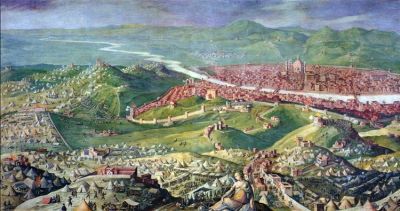
After the ten month siege of Florence (1529-30), which saw the Republic overthrown by imperial papal troupes, and Alessandro de' Medici installed as ruler of the city, the Florentine economy was in crisis. This crisis was compounded by a second plague, which, even though the city was somewhat protected by the Apennines to the north and east where the mountain passes could be closed, was thought to have claimed the artist's life. Sources differ on the exact date of his death, but documents confirm that he was buried in Basilica della Santissima Annunziata on Sept. 29, 1530, aged just 44. It was reportedly a quiet and unceremonious burial. Del Sarto was survived by his wife, Lucrezia, by some 40 years.
The Legacy of Andrea del Sarto
Although Vasari described him as an artist "senza errori" ("without errors"), del Sarto's star was eclipsed by his contemporaries Michelangelo, Raphael, and Leonardo da Vinci. For years he remained under-appreciated as the seminal Florentine artist, and his works were understudied. Only relatively recently has he come to be celebrated as one of the most important Italian artists of the early sixteenth century. Today he is recognized as an exceptional draftsman, colorist, altarpiece painter, and fresco decorator. He is known particularly for his unrivalled ability to produce effects of colour and atmosphere, and for his strikingly natural and expressive rendition of emotion. His works of careful composition, animation, and vibrancy, made a vital contribution to the development of Mannerism and many prominent Florentine artists were influenced by his style including Jacopo Pontormo and Rosso Fiorentino (two of his best students), and Francesco Salviati and Jacopino del Conte.
Del Sarto's legend was extended into the worlds of literature and stage, too, firstly by Alfred de Musset who created the play Andrea del Sarto in 1848 and which premiered in Paris. Musset used his "artistic licence" to create the character of Cordiani, the fictional lover of del Sarto's wife Lucrezia, who inspires a turbulent and melodramatic love triangle between the protagonists. The play was quickly followed in 1855 by Robert Browning's lengthy poem, "Andrea del Sarto Called the 'Faultless Painter'", which Browning presented in style of a first person monologue by an artist whose only known quotation is also one of the most famous in the history of the Renaissance: "Ah, but a man's reach should exceed his grasp, or what's a heaven for?". Moving into the twentieth century, Musset's play inspired the opera Andrea del Sarto, created by the French composer Jean-Yves Daniel-Lesur in 1968. But Shearman offered perhaps the most effortless and concise summary of del Sarto when he wrote, "From first to last, Sarto's integrity as a craftsman, his sheer professionalism, is impressively consistent; and it is characteristic of him that he refused to have his works engraved".
Influences and Connections

-
![Michelangelo]() Michelangelo
Michelangelo -
![Leonardo da Vinci]() Leonardo da Vinci
Leonardo da Vinci -
![Raphael]() Raphael
Raphael - Domenico Ghirlandaio
- Fra Bartolomeo
-
![Michelangelo]() Michelangelo
Michelangelo - Piero di Cosimo
- Gian Barile
- Raffaelino del Garbo
- Jacopo Sansovino
- Francesco Salviati
- Jacopino del Conte
- Bernardo del Buda
- Lamberto Lombardi
- Nannuccio Fiorentino
-
![Jacopo Da Pontormo]() Jacopo Da Pontormo
Jacopo Da Pontormo - Rosso Fiorentino
- Franciabigio
- Andrea Squarzzella
- Domenico Puligo
Useful Resources on Andrea del Sarto
- Andrea del Sarto: Text and IllustrationsOur PickBy Sydney J. Freedberg
- Andrea Del Sarto: The Renaissance Workshop in ActionOur PickBy Julian Brookes, Denise Allen, and Xavier F Salomon
- Andrea del SartoOur PickBy John Shearman
- Lives of the Most Eminent Painters Sculptors and ArchitectsOur PickBy Giorgio Vasari
- Painting of the High Renaissance in Rome and FlorenceBy Sydney J. Freedberg
- The Mural Painters of Tuscany: From Cimabue to Andrea Del SartoBy Eve Borsook
- Andrea Del SartoBy Alfred; Ligaran De Musset
- Color and Meaning: Practice and Theory in Renaissance PaintingBy Marcia B Hall
- Painting in Italy, 1500-1600By S J Freedberg
- The High RenaissanceBy Linda Murray
